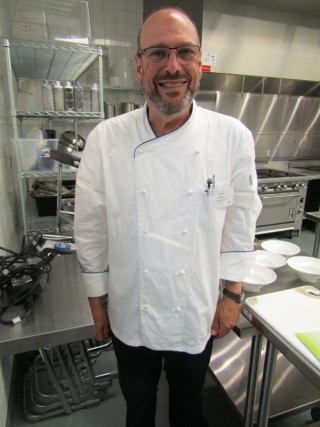
Seafood Sustainability Part Two: Where Do We Go from Here?
27 February 2023Discussing the benefits and challenges of seafood sustainability with students.
By Adam Weiner, JD, CFSE, and Stephanie Weiner, BA
Feedback & comments: This email address is being protected from spambots. You need JavaScript enabled to view it.
Last month we discussed how consumers drove restaurants and other foodservice establishments toward seafood sustainability. This month we will look at different models and how successful they are at the sustainability puzzle.
Although aquaculture has been around for thousands of years, it really didn’t become popular until trout farming in the 1950s and salmon farming in the next decade. Even so, it was in the 1980s that farmed fish became a significant part of the market.
People began eating more fish because of changes in diet and nutrition and food movements like the blackened fish craze. Overfishing began wiping out the viability of many species, hitting the larger fish varieties particularly hard. A good book to learn more about the rise and fall of the world’s fisheries as represented by salmon, cod, bass and tuna, is the book “Four Fish: The Future of the Last Wild Food” by Paul Greenberg. Here’s a spoiler alert: Overfishing has created a tragedy of the commons (read my 50 Minute Classroom article for a description). The future isn’t looking too bright for some fish as scientists have estimated that a few seafood varieties will not have catchable quantities in 30 years or less.
Is farmed fish or wild-caught fish better?
What does “better” mean? Generally speaking, farmed seafood is more sustainable. However, many people think farmed seafood is environmentally better because it does not take wild seafood from its home. However, farmed fish may sometimes have a seriously poor effect on the environment where they were raised.
If the farm is on land, precious lands such as rainforests may have been cleared to make the farm. A land-based farm can pollute local water sources. Farms also may be nothing more than pens in rivers or oceans where wild fish can get caught. For years, controversies have raged over whether farmed seafood is less healthy (or even unhealthy) to eat compared to wild seafood.
Are fishing nets bad for seafood? Why or why not?
Net fishing’s primary concern is about over-capturing the intended species. Other issues include: potentially trapping other unintended fish varieties; catching mammals such as whales, dolphins and sea lions; and confining turtles. Nets that drag along the bottom may also damage the ocean floor which diminishes the habitat for all species.
Line catching is generally better, but most commercial line fishing is not done with single hooks on a pole, as in someone fishing with a pole and line. Fishing boats have multiple lines with many hooks on them, sometimes miles long.
Is the Monterey Bay Aquarium Seafood Watch System or other systems the answer?
I think most people would say no, but it is a start. The problem is how rapidly things change. For example, the Patagonian Toothfish was an underutilized fish. One day its name was changed to Chilean Sea Bass and the demand skyrocketed so much the fish was nearly fished to extinction in a few years.
Fishing techniques can also change from one country or one region to the next. Seafood Watch might say that farmed catfish in the United States is a best choice, but that doesn’t guarantee that all farmed catfish is a best choice.
Foodservice trends, as mentioned above, also change things. Sushi was incredibly rare in this country 40 years ago. Now it is everywhere from gas stations to elementary schools. Poke was unknown beyond Hawaii less than 10 years ago. Now, it is predicted to grow to a $1.2 billion industry from 2020-2024. As we understand, most of the tuna used in poke is not farmed. (For ideas on how to teach poke bowls, particularly without using fish, see the 50 Minute Classroom article, “Beyond Poke Bowls.”)
What can I do as a teacher?
Acquaint your students with the issues first. As with all other environmental concerns, there are no clear or precise right answers or easy solutions. However, let your students know they will feel the environmental impacts much more personally than previous generations. If some experts are correct, seafood as a dinner item won’t be available in 25 to 30 years. It will be more devastating to your students than to you.
CAFÉ’s website lists several seafood and aquaculture websites on its Resource Center page. In addition, you can attend the CAFE conference where seafood industry experts make presentations and are available to talk with instructors. Click here for June 2023 Leadership Conference information.
Instructors can also look at the Monterey Bay Aquarium Seafood Watch page for more information, downloadable guides and other information. They have an entire section with resources for teachers, which includes lessons, units and projects--including a whole section on how to inspire teens to care about and for our oceans. I suspect they might even be willing to provide a virtual class or virtual field trip. And they aren’t the only ones, many aquariums and zoos have resources for teachers and a plethora of information.
In conclusion: The important thing to remember is that the only way you can go wrong is to not discuss these issues with your students. Fish and seafood are almost assuredly part of your curriculum. And, this is also a good time to utilize your concurrent learning techniques and work with your fellow science teachers and perhaps even government teachers in your school. After all, fish and seafood are not only political and scientific issues, it is also a culinary issue.
**********************************************
Click here to read 50 Minute Classroom's "Seafood Sustainability Part One: The Beginning."
Adam Weiner, JD, CFSE, has been a culinary instructor in the San Francisco Bay Area for more than 17 years.
